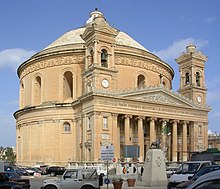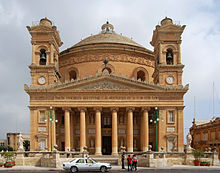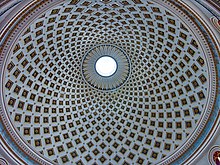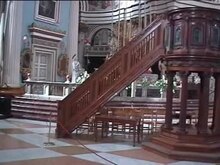Rotunda of Mosta
The Church of the Assumption of Mary , also known as the Rotunda of Mosta or Rotunda Santa Marija Assunta, is a Roman Catholic church in Mosta on the island of Malta in the state of Malta . It was inaugurated in 1860.
history
At the beginning of the 17th century there was already an older small church in its place. When the population of the city grew enormously in the 18th century, the existing church was no longer sufficient for all believers, and in 1830 it was decided to build a larger church building . The Maltese architect Giorgio Grognet de Vassé created a design that was based on the model of the Pantheon in Rome . The responsible state and church authorities approved the plans in 1832. The foundation stone was laid on May 30, 1833 , and many residents helped with both donations and voluntary service. The sacred building was not completed until March 1860. During the new construction work, the old church remained standing and the rotunda was built around it so that services can continue. After the rotunda was consecrated, the old parish church was dismantled on three days of Shrovetide and on March 11, 1860 , the then bishop Gaetano Pace Formo consecrated the church.
In April 1913 the closing ceremony of the XXIV Eucharistic Congress took place in the rotunda, attended by the papal legate Cardinal Domenico Ferrara, many cardinals, bishops and representatives of numerous states.
During an air raid in World War II , the building that dominated the cityscape was hit directly by a German aerial bomb on April 9, 1942 . But this did not explode, but only broke through the dome and remained on the floor. Since there were about 300 people in the church at that time and no one was actually injured, the event is considered a miracle . The original of the defused bomb is in the War Museum in Valletta . The damage to the church was soon repaired. A copy of the bomb can be seen in the sacristy of the Rotunda.
Dates of the rotunda and the dome
The façade of the round structure faces south, where seven columns and two supporting structures on the sides support a flat triangular gable. On both sides of the supporting structures there are church towers with a square floor plan, in which the bells hang. The south facade is 37.19 m wide and 2.27 m high, the towers are each 35.59 m high. The outer diameter of the church building is 54.86 m, the walls have a thickness of 8.38 m at the bottom so that they can support the weight of the dome. The dome should, according to the rectory, the fourth largest self-supporting dome churches in the world (see list of largest domes of its time ), after the St. Peter's Basilica in Rome , the Florence Cathedral and the Roman Pantheon. Their inner diameter is 35.97 meters. The height of the dome inside, measured from the floor to the lantern, is 56.38 meters.
Furnishing
The interior is all in blue, gold and white. All of the paintings are by Maltese artists. The floor is covered with ornamentally designed marble slabs.
The main altar painting in the chancel depicts the Assumption of the Virgin . It is the work of the painter Stefano Erardi (1630–1716), which was created for the old, small previous church and was adapted in 1860 for the much larger rotunda by the artist Salvatore Barbara. In 1920 and 1974 restorations were carried out by Mourice Cordina.
The statue of Mary to the left of the entrance in a niche is more conspicuous than the altarpiece . It also depicts the Assumption of Mary and goes back to a figure in the Nazarene style created by the Maltese sculptor Salvatore Dimech in 1868 for the previous church . However, the parish later wanted a more modern image of the Virgin Mary and in 1947 commissioned the sculptor Vincent Apap to carry out a comprehensive restoration. However, only the original base was retained.
Web links
Individual evidence
- ↑ a b c d Flyer Mosta and the Rotunda , Ed. Parish Office Mosta, 2011.
- ↑ The bomb in Mosta, in wordpress.com
Coordinates: 35 ° 54 '36.3 " N , 14 ° 25' 32.9" E





